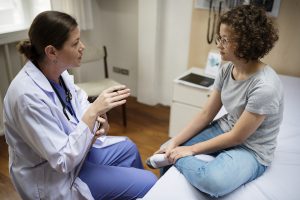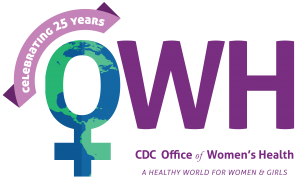Promoting and protecting the health of women and girls: In celebration of the Office of Women’s Health on their 25th Anniversary!
Posted on byCongratulations to CDC’s Office of Women’s Health (OWH) on celebrating 25 years! That’s 25 years of promoting public health research, evidence-based programs, policies, and strategies that improve the health and safety of all women and girls. It is quite an accomplishment.
The Division of Reproductive Health (DRH) is pleased to have collaborated with OWH throughout this time. DRH’s mission to ensure  optimal and equitable reproductive health for all makes working with OWH a natural fit. Over the past 25 years, we have made significant progress in the advancement of women’s and girls’ health. Looking back to 1994, DRH released the monograph “From Data to Action: CDC’s Public Health Surveillance for Women, Infants and Children.”[i] It provided an overview of public health surveillance and data programs at CDC that address women’s health. It offered practitioners and planners at the state, local and national levels information on the uses and limitation of such data.[ii]
optimal and equitable reproductive health for all makes working with OWH a natural fit. Over the past 25 years, we have made significant progress in the advancement of women’s and girls’ health. Looking back to 1994, DRH released the monograph “From Data to Action: CDC’s Public Health Surveillance for Women, Infants and Children.”[i] It provided an overview of public health surveillance and data programs at CDC that address women’s health. It offered practitioners and planners at the state, local and national levels information on the uses and limitation of such data.[ii]
More recently, we have seen the national teen birth rate fall to an all-time low. In 1970, about 68 teens in every 1,000 had a baby. Today, that rate has dropped to 18.8—the lowest rate ever seen. DRH tested a set of innovative community-wide approaches to reduce teen pregnancies and births. These projects demonstrated the effectiveness of innovative, multi-component, community-wide initiatives in reducing rates of teen pregnancy and births in communities with the highest rates. The initiatives linked prevention efforts and clinical services and engaged more teens in evidence-based programs.
Over time, DRH has partnered with HRSA’s Maternal Child Health Bureau to provide direct technical assistance to states through the Maternal and Child Health Epidemiology Program (MCHEP). MCHEP focuses on promoting and improving the health and well-being of women, children, and families by building capacity at state, local, and tribal levels and applying sound epidemiologic research and scientific information to maternal and child health programs and policies. MCHEP has assigned more than 35 senior CDC epidemiologists focused on maternal child health epidemiology capacity building and applied research to 20 states, and 6 other public health agencies and organizations.
Throughout the past 25 years, DRH has expanded the Pregnancy Risk Assessment Monitoring System (PRAMS). PRAMS collects state- specific, population-based data on maternal attitudes and experiences before, during, and shortly after pregnancy. We use these data to identify women and infants at high risk for health problems, to monitor changes in health status, and to measure progress towards goals in improving the health of mothers and infants. Researchers also use PRAMS data to investigate emerging reproductive health issues, while state and local governments use PRAMS data to plan and review their programs and policies for reducing maternal and infant morbidity and mortality. Forty-seven states, New York City, Puerto Rico, the District of Columbia and the Great Plains Tribal Chairmen’s Health Board (GPTCHB) currently participate in PRAMS, representing approximately 83% of all U.S. live births.[iii] DRH is committed to preserving the progress PRAMS has made over the past 25 years.
specific, population-based data on maternal attitudes and experiences before, during, and shortly after pregnancy. We use these data to identify women and infants at high risk for health problems, to monitor changes in health status, and to measure progress towards goals in improving the health of mothers and infants. Researchers also use PRAMS data to investigate emerging reproductive health issues, while state and local governments use PRAMS data to plan and review their programs and policies for reducing maternal and infant morbidity and mortality. Forty-seven states, New York City, Puerto Rico, the District of Columbia and the Great Plains Tribal Chairmen’s Health Board (GPTCHB) currently participate in PRAMS, representing approximately 83% of all U.S. live births.[iii] DRH is committed to preserving the progress PRAMS has made over the past 25 years.
But while great progress has been made, much work remains. Over the past decade, we have seen maternal mortality rates go up. DRH has a new Notice of Funding Opportunity, “Preventing Maternal Deaths: Supporting State Maternal Mortality Review.” This funding will improve our understanding of the drivers of maternal mortality and complications of pregnancy and associated disparities and identify initiatives to implement in the right places for families and communities who need them most. Preterm birth rates are going in the wrong direction and need continued attention to ensure that past progress is not lost and that outcomes continue to improve for women and infants. We need to better understand the multitude of factors affecting maternal health and its connections to fetal and infant health, which may be driving recent increases in preterm birth. Whether we are working to improve maternal mortality surveillance, prevent teen and unintended pregnancies, or building local epidemiology capacity to improve the health of women, children and families, we will continue to work hand in hand with the CDC Office of Women’s Health to protect and promote the health of all women and girls for years to come.
new Notice of Funding Opportunity, “Preventing Maternal Deaths: Supporting State Maternal Mortality Review.” This funding will improve our understanding of the drivers of maternal mortality and complications of pregnancy and associated disparities and identify initiatives to implement in the right places for families and communities who need them most. Preterm birth rates are going in the wrong direction and need continued attention to ensure that past progress is not lost and that outcomes continue to improve for women and infants. We need to better understand the multitude of factors affecting maternal health and its connections to fetal and infant health, which may be driving recent increases in preterm birth. Whether we are working to improve maternal mortality surveillance, prevent teen and unintended pregnancies, or building local epidemiology capacity to improve the health of women, children and families, we will continue to work hand in hand with the CDC Office of Women’s Health to protect and promote the health of all women and girls for years to come.
Special thanks to RADM Barfield for contributing this blog as part of the celebration of the 25th anniversary commemoration of CDC’s Office of Women’s Health. Our theme for the 25th anniversary commemoration is A Healthy World for Women and Girls .
[i] https://www.cdc.gov/reproductivehealth/drh/about-us/DRH-timeline.htm
[ii] From Data to Action: CDC’s Public Health Surveillance for Women, Infants and Children. US Department of Health and Human Services, CDC Monograph 1994.
18 comments on “Promoting and protecting the health of women and girls: In celebration of the Office of Women’s Health on their 25th Anniversary!”
Comments listed below are posted by individuals not associated with CDC, unless otherwise stated. These comments do not represent the official views of CDC, and CDC does not guarantee that any information posted by individuals on this site is correct, and disclaims any liability for any loss or damage resulting from reliance on any such information. Read more about our comment policy ».



After study a few of the blog posts on your website now, and I truly like your way of blogging. I bookmarked it to my bookmark website list and will be checking back soon. By the way, you have taken a nice step of promoting and protecting the health of women and girls.
The Initiatives taken by DRH along with OWH are very commendable. Especially the PRAMS , it is very beneficial for the Mothers and their infants. Its very good to see that there are such good organisations working for the well being of Women.
The Initiatives taken by DRH along with OWH are very commendable. Especially the PRAMS , it is very beneficial for the Mothers and their infants. Its very good to see that there are such good organisations working for the well being of Women.
Its very good to see that there are such good organisations working for the well being of Women.
Prevention requires interventions to promote healthy behaviours and reduce risk factors and governments need to take steps to overcome economic, socio-cultural health inequalities and geographic barriers. “Changing reproductive health needs over the life cycle” includes the prevention, diagnosis, and treatment of reproductive system cancers.
Thanks for providing such an awesome content and welcome to such good organisations working for the well being of Women.
—
Regards,
Sourav
nice article
I’m curious whatever happened with the updated DTA chapters that various CDC authors collaborated on. It’s a shame those could not be released in time for the 25th anniversary, but better late than never.
Very informative content
Amazing Blog Thanks for sharing
I like this website its a master peace ! Glad I found this on google .
Awesome article sir
Very informative content
Thanks For sharing
newsverse.info
I’m curious whatever happened with the updated DTA chapters that various CDC authors collaborated on. It’s a shame those could not be released in time for the 25th anniversary, but better late than never.
Very nice blog.
this is very important information for me
Thank you very much for sharing this blog.
Wonderfull keep sharing Awesome post